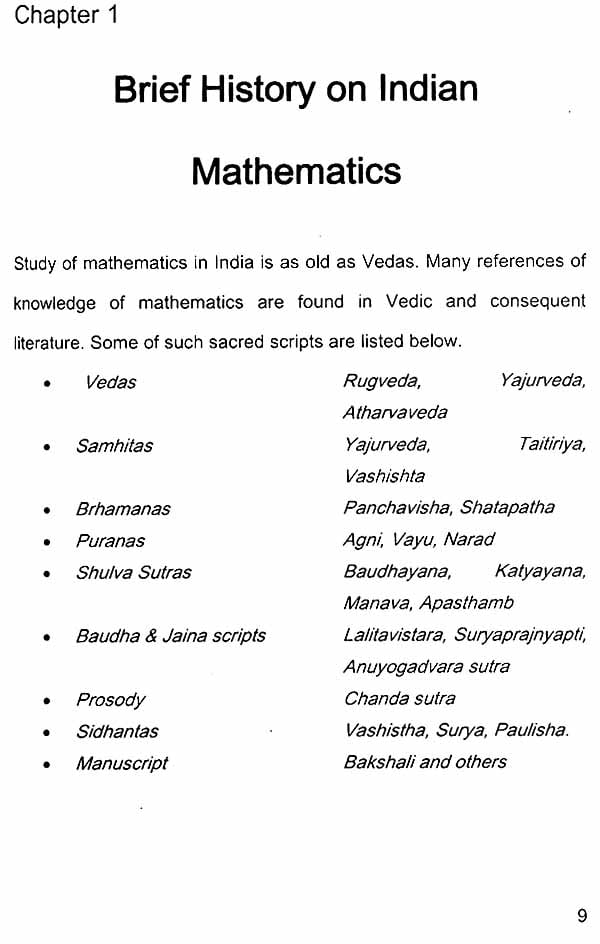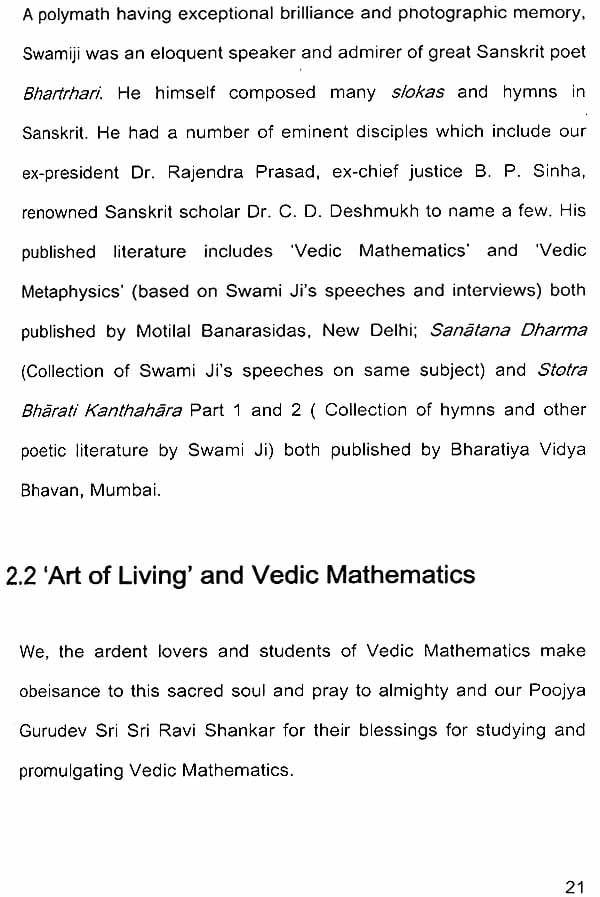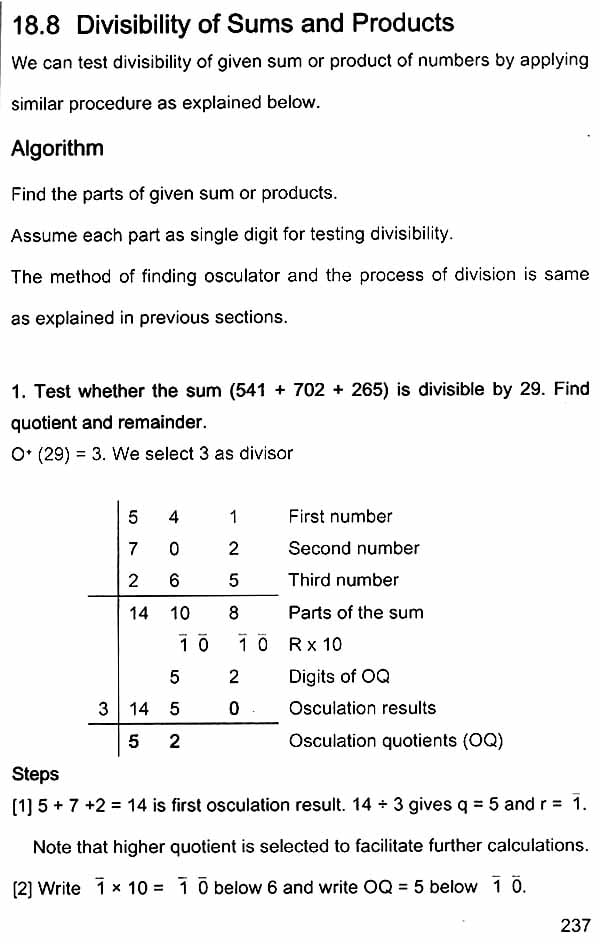
Enjoy Vedic Mathematics
Book Specification
| Item Code: | NAP322 |
| Author: | Shriram M. Chauthaiwale and Dr. Ramesh Kolluru |
| Publisher: | Sri Sri Publications Trust |
| Language: | English |
| Edition: | 2013 |
| ISBN: | 9789380592749 |
| Pages: | 244 |
| Cover: | Paperback |
| Other Details | 8.5 inch X 5.5 inch |
| Weight | 310 gm |
Book Description
Back of The Book
What is Vedic Mathematics?
Vedic Mathematics is ancient system of mathematics which was formulated and encapsulated in modern from by jagadguru Swami Bharthi Krishna Tirtha ji. He is the 143rd Shankaracharya of Goverdhan Peeth, Pur. He formulated sixteen sutras and thirteen upasutras. These sutras can be applied effectively in conventional mathematics for faster solutions than the methods usually being.
Why should one know Vedic mathematics?
The solution of the problem can be viewed in different dimensions, providing variety of ways to get the answer which is derived in a simple, fast and accurate manner.
How effective are Vedic math techniques?
Multiplication tables up to 5 are sufficient to solve a problem in Vedic Maths. It has the capability of performing multiple operations at one time-Vedic mathematics optimally utilizes both hemi-spheres of the brain is the seat of language and processes in a logical and sequential order, while the right side is visual(spatial), intuitive, random booting of memory and concentration.
Will it support school curriculum?
The Vedic Maths methods are parallel and supplemental to the school study. It does not confuse the child. Vedic Maths focus is on mastering the core skills that a child needs: to be successful in secondary education and beyond.The course syllabus can be designed dynamically in tandem with the school curriculum. This helps developing the mental abilities of a child. We can custom design Vedic Maths course according to the school academic requirements.
Will Vedic Maths be useful for higher classes?
Yes, concepts such as Quadratic Equations Simulatneous Equations, Trigonometry and even Calculus have been mad simple and easier Vedic mathematics.
Will Vedic Maths help a student to minimize careless mistakes?
In Vedic mathematics the one-line mental formulae have an inbuilt series o verifying methods. Therefore the chance for a wrong answer is minimized.
Shriram M. Chauthaiwale M.Sc. B.Ed working as lecturer in Mathematics since 30 years. He published 3 books on history of mathematics and 1 on Vedic mathematics with CD. 20 odd research papers published in national and international journals and conferences. Numerous articles in news papers and magazines. All india radio talk and Doodarshan T.V. program on Vedic Mathematics since 2008.
Dr. Ramesh completed M.Sc. and Ph.D in Statistics from Indian Agricultural Research Institute, New Delhi. Worked as a Technical consultant for software development for one year, but his fascination for numbers found a creative channel when he joined as the Head of Vedic Mathematics Department, Ved Vignan Maha Vidya Peeth (VVMVP) The Art of Living Foundation in July 2006.
Trained more than 120 teachers in Vedic Mathematics. Taken Vedic Mathematics (classroom and online) courses for national and international participants. Had given talk on Vedic Mathematics in World Space Radio.
In India higher and evolved forms of mathematics were in practice since the Vedic times as well seen through the instances found in the Vedas and related literature.
Swami Bharthi Krisna Tirtha (143rd Shankaracharya of Govardhana Peeth, Puri) derived 16 Sutras and 13 Upa-sutras which can be universally applied in various disciplines of mathematics. He followed the same tradition while explaining mathematics principles and procedueres.
These Sutras were found to be very effective and enjoyable, with the help of which many mathematics operations ranging from simple addition-subtraction to more difficult topics like Algebra, Differentiation, Integration, Trigonometry an Gemotry can be solved with ease. He gave his methods the name Vedic Mathematics through many misunderstand Vedic Mathematics to being the mathematical concepts enumerated in the Vedas.
The Beauty of Vedic Mathematics is it approaches through simple and direct, single line, non-monotonic, multi-choice, direction independent and faster methods unlike conventional mathematics. This definitely leaves behind wide options in the methodologies to be chosen. Vedic maths ensures a balanced utility of both the right and left brain (logic and creativity respectively). Through Vedic Mathematics the path to infinite wisdom on maths is enjoyable and creative.
Contents
| 9 | ||
| 1.1 | Numbers and Arithmetic | 11 | |
| 1.2 | Algebra | 12 | |
| 1.3 | Geometry | 13 | |
| Intorduction to Vedic Mathematics | 17 | ||
| 2.1 | Life and works of Bharati Krishna Teertha Ji | 17 | |
| 2.2 | Art of Living' and Vedic Mathematics | 21 | |
| 2.3 | Advantages of Vedic Mathematics | 22 | |
| Sutras | 24 | ||
| 3.1 | Meaning of the Sutras | 24 | |
| 3.2 | Sapta Sutrani (Seven Sutras) | 27 | |
| 3.3 | Pancha Upsutrani (Five Upasutra) | 29 | |
| 3.4 | Other UpSutras | 31 | |
| Fundamental Concepts | 33 | ||
| Definations | 33 | ||
| 4.1 | Complement of the number (Purakanka) | 34 | |
| 4.2 | Digital Root of the Number | 36 | |
| 4.3 | Vinculum Numbers | 37 | |
| 4.4 | Normal toVinculum Conversion | 38 | |
| 4.5 | Vinculum to Normal Conversion | 40 | |
| 4.6 | Multiplication Tables | 40 | |
| Operators | 42 | ||
| Additon | 48 | ||
| 5.1 | Place-wise Addition Method | 48 | |
| 5.2 | Addition by Shuddha Method | 50 | |
| Subtraction of the Numbers | 53 | ||
| 6.1 | Subtraction by Shuddha Method | 53 | |
| 6.2 | Vinculum Subtraction | 56 | |
| 6.3 | Simultaneous Addition and Substraction | 58 | |
| Urdhvatiryak Multiplication | 60 | ||
| 7.1 | Single Digit Multiplier | 61 | |
| 7.1.1 | 1 x 1 Multiplication | 61 | |
| 7.1.2 | 2 x 1 Multiplication | 61 | |
| 7.1.3 | 3 x 1 Multiplication | 63 | |
| 7.1.4 | 4 x 1 Multiplication | 64 | |
| 7.2 | Two-Digit Multiplier | 66 | |
| 7.2.1 | 2 x 2 Multiplication | 66 | |
| 7.2.2 | 3 x 2 Multiplication | 68 | |
| 7.2.3 | 4 x 2 Multiplication | 70 | |
| 7.3 | Three-Digit Multiplier | 71 | |
| 7.3.1 | 3 x 3 Multiplication | 71 | |
| 7.3.2 | 4 x 3 Multiplication | 73 | |
| 7.4 | Four-Digit Multiplier | 75 | |
| 7.4.1 | 4 x 4 Multiplication | 75 | |
| 7.5 | Decimal Number Multiplications | 77 | |
| Multiplications | 80 | ||
| (Some Special Cases) | 80 | ||
| 8.1 | Antyayordashke'pi_10 Multiplication | 81 | |
| 8.2 | Antyayordashke'pi_100 Multiplication | 84 | |
| 8.3 | Antyayordashke'pi_1000 Multiplication | 86 | |
| 8.4 | Multiplier is 9,99,999 or 9999 | 88 | |
| 8.4.1 | Equal number of digits in multiplicand and Multiplier | 88 | |
| 8.4.2 | Lesser number of digits ni multiplicand | 91 | |
| Alogorithim | 91 | ||
| 8.4.3 | Multiplicand with grater number of digits | 92 | |
| 8.5 | Multiplication by 11 | 94 | |
| 8.6 | Multiplication by 101 | 96 | |
| 8.7 | Multiplication by 1001 | 98 | |
| Sum of Products & Product of Sums | 101 | ||
| 9.1 | The Sum of Products: Single digit multiplier | 101 | |
| 9.2 | Sum of Products: Two digit multiplier | 104 | |
| 9.3 | Sum of Products: Three and Four digit multiplier | 107 | |
| 9.4 | Sum of Products of Decimal number | 109 | |
| 9.5 | The Product of Sums and differences | 111 | |
| Base Multiplication | 116 | ||
| 10.1 | Definitions | ||
| 10.2 | (a) Near to base 10 | 118 | |
| 10.2 | (b) Near to working base m x 10 | 120 | |
| 10.3 | (a) Near to base 100 | 122 | |
| 10.3 | (b) Near to working base m x 100 | 123 | |
| 10.4 | (a) Near to base 1000 | 124 | |
| 10.4 | (b) Near to working base m x 1000 | 126 | |
| 10.05 | Very near numbers (Nikhilam Method) | 127 | |
| Squares | 131 | ||
| 11.1 | Anurupyena Method | 131 | |
| 11.2 | Duplex Method | 133 | |
| 11.2 | (a) Square of two-digit number | 134 | |
| 11.2 | (b) Square of three-digit number | 136 | |
| 11.2 | (c) Square of four-digit number | 138 | |
| 11.3 | Square of the number by Nikhilam method | 139 | |
| 11.4 | Square of Number ending with 5 | 142 | |
| 11.5 | Squares of numbers near 50, 500 or 5000 | 143 | |
| Sum/Products of Squares | 146 | ||
| 12.1 | Duplex Method for Sum and Difference of Squares | 146 | |
| 12.2 | Nikhilam Method for Sum and difference of Squares | 149 | |
| 12.3 | Multiplication with squares of a Number | 152 | |
| Cubes | 156 | ||
| 13.1 | Anurupyena Method for Cube of number | 156 | |
| 13.2 | Sum or Difference of Cubes | 159 | |
| 13.3 | Nikhilam Method for Cube of Number | 160 | |
| 13.4 | Product with Cubes of Two digit Numbe | 164 | |
| Dhajanka Division | 167 | ||
| 14.1 | Division with Single Digit Divisor | 167 | |
| 14.2 | Division with Two Digit Divisor | 170 | |
| 14.3 | Division with Three Digit Divisor | 174 | |
| 14.4 | Division with Four Digit Divisor | 177 | |
| Division of Sums/Products | 180 | ||
| 15.1 | Division of Sums | 181 | |
| 15.2 | Division of Product | 185 | |
| 15.3 | Division of Sums of Products | 189 | |
| 15.4 | Division of Product of Sums | 192 | |
| 15.5 | Division of Squares and Cubes | 194 | |
| Square Roots of Number | 197 | ||
| 16.1 | Facts of Note | 197 | |
| 16.2 | Square Roots by Vilokanam | 199 | |
| 16.3 | Square Roots by Dwandvayoga Method | 201 | |
| 16.4 | Square Roots of Sum or Product of Numbers | 250 | |
| 16.5 | Square Roots of Sums of Squares | 208 | |
| Cube Roots | 211 | ||
| 17.1 | Facts of Note | 211 | |
| 17.2 | Cube Roots by Vilokanam | 213 | |
| 17.3 | Cube Roots by Division Method | 215 | |
| Divisibility | 220 | ||
| 18.1 | Divisibility Test for 2,4 and 8 | 221 | |
| Test for 2 | 221 | ||
| Test for 4 | 221 | ||
| Test for 8 | 222 | ||
| 18.2 | Divisibility Test for 3 and 6 | 222 | |
| Test for 3 | 222 | ||
| Test for 6 | 223 | ||
| 18.3 | Divisibility Test for 5 and 10 | 223 | |
| 18.4 | Divisibility Test for divisor ending in 9 | 223 | |
| Test for divisor ending in 9 | 224 | ||
| 18.5 | Divisibility Test for divisor ending in 3 | 227 | |
| Test of divisor ending in 3 | 228 | ||
| 18.6 | Divisibility Test divisor ending in 1 | 231 | |
| Test for divisor ending in 1 | 231 | ||
| 18.7 | Divisibility Test divisor ending in 7 | 234 | |
| Test of divisor ending in 7 | 234 | ||
| 18.8 | Divisibility of Sums and Products | 237 | |
Sample Pages













